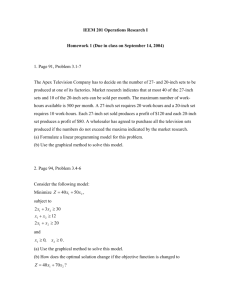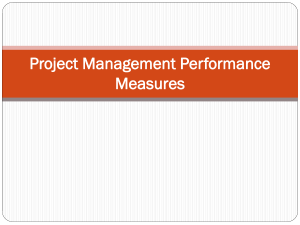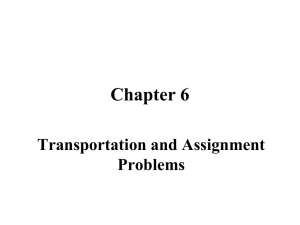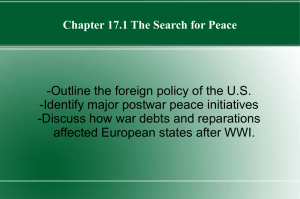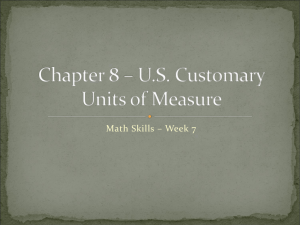Worked Examples
advertisement
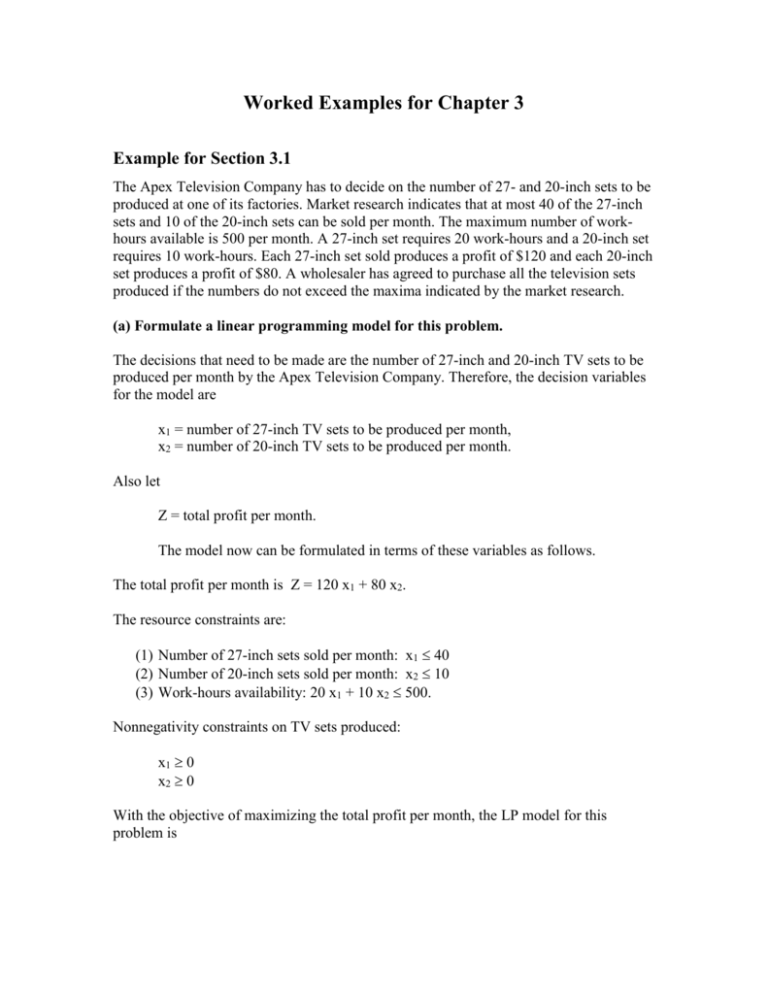
Worked Examples for Chapter 3 Example for Section 3.1 The Apex Television Company has to decide on the number of 27- and 20-inch sets to be produced at one of its factories. Market research indicates that at most 40 of the 27-inch sets and 10 of the 20-inch sets can be sold per month. The maximum number of workhours available is 500 per month. A 27-inch set requires 20 work-hours and a 20-inch set requires 10 work-hours. Each 27-inch set sold produces a profit of $120 and each 20-inch set produces a profit of $80. A wholesaler has agreed to purchase all the television sets produced if the numbers do not exceed the maxima indicated by the market research. (a) Formulate a linear programming model for this problem. The decisions that need to be made are the number of 27-inch and 20-inch TV sets to be produced per month by the Apex Television Company. Therefore, the decision variables for the model are x1 = number of 27-inch TV sets to be produced per month, x2 = number of 20-inch TV sets to be produced per month. Also let Z = total profit per month. The model now can be formulated in terms of these variables as follows. The total profit per month is Z = 120 x1 + 80 x2. The resource constraints are: (1) Number of 27-inch sets sold per month: x1 40 (2) Number of 20-inch sets sold per month: x2 10 (3) Work-hours availability: 20 x1 + 10 x2 500. Nonnegativity constraints on TV sets produced: x1 0 x2 0 With the objective of maximizing the total profit per month, the LP model for this problem is Maximize Z = 120 x1 + 80 x2, subject to x1 40 x2 10 20 x1 + 10 x2 500 and x1 0, x2 0. (b) Use the graphical method to solve this model. The constraint, x1 40 , has a constraint boundary at x1 = 40. Similarly, the constraint, x2 10, has a constraint boundary at x2 = 10. The constraint boundary for the constraint, 20 x1 + 10 x2 500, intercepts the x1-axis at 20x1 + 10(0) = 500, so at x1 = 25. Similarly, this constraint boundary intercepts the x2-axis at 20(0) + 10x2 = 500, so at x2 = 50. This constraint boundary lies well within the constraint boundary for the first constraint, x1 40, so the first constraint is redundant and can be ignored. For a sample value of Z, say, Z = 2,400, the corresponding objective function line, Z = 2,400 = 120 x1 + 80 x2, intercepts the x1-axis at 120 x1 + 80(0) = 2,400, so at x1 = 20. It intercepts the x2-axis at 120 (0) + 80 x2 = 2,400, so at x2 = 30. The corresponding objective function lines for other values of Z are parallel to this line. Pushing these lines up as much as possible while still passing through a point in the feasible region reveals that the optimal solution is (x1, x2) = (20, 10) with Z = 3,200, as depicted in the following graph. Example for Section 3.4 Dwight is an elementary school teacher who also raises pigs for supplemental income. He is trying to decide what to feed his pigs. He is considering using a combination of pig feeds available from local suppliers. He would like to feed the pigs at minimum cost while also making sure each pig receives an adequate supply of calories and vitamins. The cost, calorie content, and vitamin content of each feed are given in the table below. Contents Calories (per pound) Vitamins (per pound) Cost (per pound) Feed Type A 800 140 units $0.40 Feed Type B 1,000 70 units $0.80 Each pig requires at least 8,000 calories per day and at least 700 units of vitamins. A further constraint is that no more than one-third of the diet (by weight) can consist of Feed Type A, since it contains an ingredient which is toxic if consumed in too large a quantity. (a) Formulate a linear programming model for this problem. Let A and B be the quantity (pounds) of Feed Type A and Feed Type B, respectively, used per day. Also let Z be the total daily cost of the feed per pig. Then, the daily cost is Z = $0.4 A + $0.8 B. The constraints on the minimum daily requirements of calories and vitamins are (1) Calories requirement: 800 A + 1000 B 8,000. (2) Vitamins requirement: 140 A + 70 B 700. Also, Dwight needs to avoid using too much of Feed Type A because of the toxic ingredient in it. The toxic constraint is A 1/3 (A+B), which reduces to 2/3 A - 1/3 B ≤ 0. Nonnegativity constraints: A 0, B 0. The resulting linear programming model for this problem is Minimize subject to Z = 0.4 A + $0.8 B, 800 A + 1000 B 8000 140 A + 70 B 700 2/3 A - 1/3 B 0 and A 0, B 0. (b) Use the graphical method to solve this model. What is the resulting daily cost per pig? As shown below, the optimal solution is (A, B) = (20/7, 40/7). The resulting daily cost per pig is Z = 40/7 = $5.71. Example for Sections 3.4 and 3.5 The Fagersta Steelworks currently is working two mines to obtain its iron ore. This iron ore is shipped to either of two storage facilities. When needed, it then is shipped on to the company’s steel plant. The diagram below depicts this distribution network, where M1 and M2 are the two mines, S1 and S2 are the two storage facilities, and P is the steel plant. The diagram also shows the monthly amounts produced at the mines and needed at the plant, as well as the shipping cost and the maximum amount that can be shipped per month through each shipping lane. 40 tons produced $2,000/ton 30 tons max. M1 S1 $400/ton 70 tons max. $1,700/ton 30 tons max. P $1,600/ton 50 tons max. 60 tons M2 produced $1,100/ton 50 tons max. 100 tons needed $800/ton 70 tons max. S2 Management now wants to determine the most economic plan for shipping the iron ore from the mines through the distribution network to the steel plant. (a) Formulate a linear programming model for this problem. The decision variables are defined as follows: xm1-s1 : xm1-s2 : xm2-s1 : xm2-s2 : xs1 -p : xs2 -p : number of units (tons) shipped from Mine 1 to Storage Facility 1, number of units (tons) shipped from Mine 1 to Storage Facility 2, number of units (tons) shipped from Mine 2 to Storage Facility 1, number of units (tons) shipped from Mine 1 to Storage Facility 2, number of units (tons) shipped from Storage Facility 1 to the Plant, number of units (tons) shipped from Storage Facility 2 to the Plant. The total shipping cost is: Z = 2000 xm1-s1 + 1700 xm1-s2 + 1600 xm2-s1 + 1100 xm2-s2 + 400 xs1-p + 800 xs2-p The constraints we need to consider are: (1) Supply constraint on M1 and M2: xm1-s1 + xm1-s2 = 40 xm2-s1 + xm2-s2 = 60 (2) Conservation-of-flow constraint on S1 and S2: xm1-s1 + xm2-s1 - xs1-p = 0 xm1-s2 + xm2-s2 - xs2-p = 0 (3) Demand constraint on P: xs1-p + xs2-p = 100 (4) Capacity constraints: xm1-s1 30, xm1-s2 30 xm2-s1 50, xm2-s2 50 xs1-p 70, xs2-p 70 (5) Nonnegativity constraints: xm1-s1 0, xm1-s2 0 xm2-s1 0, xm2-s2 0 xs1-p 0, xs2-p 0 The resulting linear programming model for this problem is: Maximize Z = 2000 xm1-s1 + 1700 xm1-s2 + 1600 xm2-s1 + 1100 xm2-s2 + 400 xs1-p + 800 xs2-p, subject to xm1-s1 + xm1-s2 = 40 xm2-s1 + xm2-s2 = 60 xm1-s1 + xm2-s1 - xs1-p = 0 xm1-s2 + xm2-s2 - xs2-p = 0 xs1-p + xs2-p = 100 xm1-s1 30, xm1-s2 30 xm2-s1 50, xm2-s2 50 xs1-p 70, xs2-p 70 and xm1-s1 0, xm1-s2 0 xm2-s1 0, xm2-s2 0 xs1-p 0, xs2-p 0 (b) Solve this model by the simplex method. This model can be solved by using the Excel Solver,which employs the simplex method. This spreadsheet formulation and solution of the problem is shown next.

